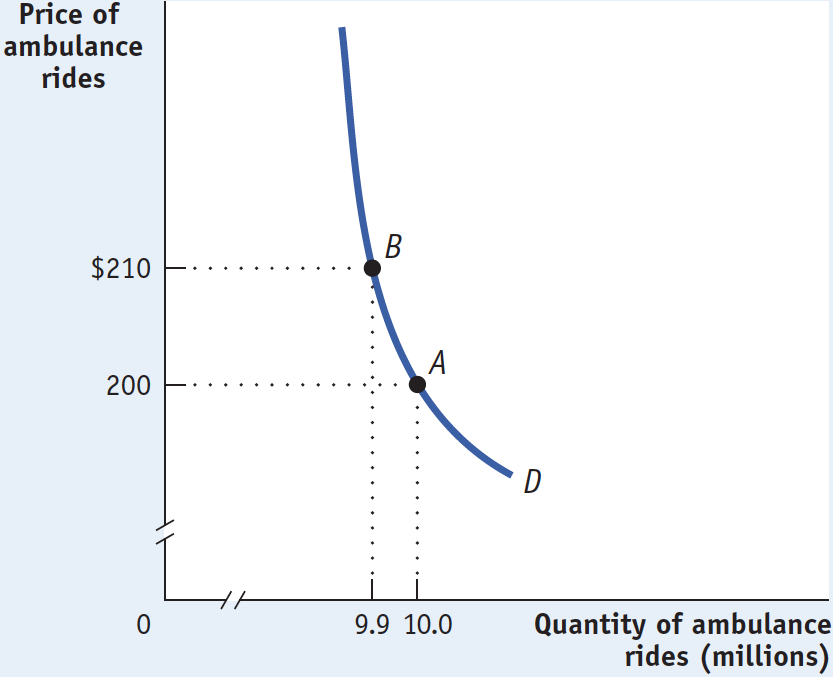Calculating the Price Elasticity of Demand
Figure 6-1 shows a hypothetical demand curve for an ambulance ride. At a price of $200 per ride, consumers would demand 10 million rides per year (point A); at a price of $210 per ride, consumers would demand 9.9 million rides per year (point B).

Figure 6-1, then, tells us the change in the quantity demanded for a particular change in the price. But how can we turn this into a measure of price responsiveness? The answer is to calculate the price elasticity of demand.
The price elasticity of demand is the ratio of the percent change in the quantity demanded to the percent change in the price as we move along the demand curve.
The price elasticity of demand is the ratio of the percent change in quantity demanded to the percent change in price as we move along the demand curve. As we’ll see later in this chapter, the reason economists use percent changes is to obtain a measure that doesn’t depend on the units in which a good is measured (say, a 1-
To calculate the price elasticity of demand, we first calculate the percent change in the quantity demanded and the corresponding percent change in the price as we move along the demand curve. These are defined as follows:

and

In Figure 6-1, we see that when the price rises from $200 to $210, the quantity demanded falls from 10 million to 9.9 million rides, yielding a change in the quantity demanded of 0.1 million rides. So the percent change in the quantity demanded is

The initial price is $200 and the change in the price is $10, so the percent change in price is

To calculate the price elasticity of demand, we find the ratio of the percent change in the quantity demanded to the percent change in the price:

In Figure 6-1, the price elasticity of demand is therefore

Notice that the minus sign that appeared in the calculation of the percent change in the quantity demanded has been dropped when we calculate this last equation, the price elasticity of demand. Why have we done this? The law of demand says that demand curves are downward sloping, so price and quantity demanded always move in opposite directions. In other words, a positive percent change in price (a rise in price) leads to a negative percent change in the quantity demanded; a negative percent change in price (a fall in price) leads to a positive percent change in the quantity demanded. This means that the price elasticity of demand is, in strictly mathematical terms, a negative number.
However, it is inconvenient to repeatedly write a minus sign. So when economists talk about the price elasticity of demand, they usually drop the minus sign and report the absolute value of the price elasticity of demand. In this case, for example, economists would usually say “the price elasticity of demand is 0.2,” taking it for granted that you understand they mean minus 0.2. We follow this convention here.
The larger the price elasticity of demand, the more responsive the quantity demanded is to the price. When the price elasticity of demand is large—
As we’ll see shortly, a price elasticity of 0.2 indicates a small response of quantity demanded to price. That is, the quantity demanded will fall by a relatively small amount when price rises. This is what economists call inelastic demand. And inelastic demand is exactly what enables an ambulance operator to increase the total amount earned by raising the price of an ambulance ride.